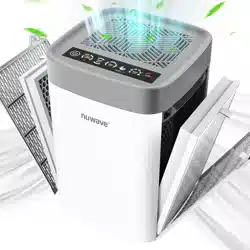Loading ...
Loading ...
Loading ...

14 | nuwavenow.com
Call: 877-689-2838
The OxyPureHEPA500 was tested for electrical
safety against the ANSI/UL507 electrical safety
standards, and were found to be fully compliant.
Formaldehyde, VOCs, and Fumes
Formaldehyde is a colorless, strong-smelling gas
that belongs to a family of chemicals called Vol-
atile Organic Compounds (VOCs). Most people
think of it as a preservative for medical specimens
and mortuary work, but it is also used in a variety
of other ways, such as making particleboard,
plywood, and berboard; glues and adhesives;
permanent-press fabrics; paper product coatings;
and some insulation materials. It is also used to
make other chemicals and as a preservative in
certain foods, antiseptics, medicines, and cos-
metics.
The main way people are exposed to formal-
dehyde is by inhaling it. In liquid form it can be
absorbed through the skin. People can also be
exposed to small amounts by eating foods or
drinking liquids containing formaldehyde.
TEST RESULTS
ENERGYSTAR • FORMALDEHYDE • CADR
EnergySTAR Certication
The U.S. Environmental Protection Agency (EPA)
has published specications of energy efciency
using a Clean Air Delivery Rate (CADR) to Watt
ratio. The unit being tested must produce a CADR
of at least 50 for smoke. Minimum performance is
2.0 CADR/Watt and the standby power require-
ment is 2.0 Watts. The OxyPure passed the test
handily.
Electrical Safety
Along with energy efciency comes safety. The
California Air Resources Board (CARB) ensures
that every air purier sold in California meets
certain standards for electrical safety and perfor-
mance.
Test Standard Measured
Electrical Safety ANSI/UL507 Compliant
Exposure to relatively high amounts of formalde-
hyde in medical and occupational settings has
been linked to some types of cancer in humans,
but the effect of exposure to small amounts is
less clear. Studies of people exposed to formal-
dehyde in the workplace have also found a possi-
ble link to cancer of the nasal sinuses.
At present, the limit is at 0.70 parts per million
(ppm) on average over an 8 hour workday. The
highest concentration that a worker can be ex-
posed to is 2 ppm, and that can only occur over
15 minutes.
https://www.cancer.org/cancer/cancer-causes/formaldehyde.html
The OxyPure was tested against formaldehyde to
see how well the unit would remove it, as similar
gases, VOCs and fumes.
Gases, VOCs, Fumes Removal Rate Time (Min.)
Formaldehyde 97.4% 240
Clean Air Delivery Rate & Removal Efciency
The Clean Air Delivery Rate (CADR) measures
clean air ow out of the unit against different air
pollutants, in this case smoke, dust and pollen.
There are a number of different factors that go
into CADR from particle size and composition to
fan speed to lter cleanliness. You can see this in
the following chart:
Notice that while the particle size for each is the
same, the CADR for each kind of particle is mark-
edly different, with dust having the lowest CADR
while pollen has the highest by a wide margin.
Smoke, dust and pollen are not the only particle
pollutants that can nd in your home. The table
on the next page will introduce you to some of
them and put their size into perspective for you.
Particulate Matter
(Size in microns)
CADR
(Ft³/Min.)
Removal
Efciency
Smoke (0.1µm-1µm) 150.6 100% in 100 minutes
Dust (0.5 µm-3 µm) 149.8 100% in 2 hours
Pollen (5 µm-11 µm) 181.5 100% in 40 minutes
Criteria Standard Measured
Smoke CADR (ft³/min.) >50 150.6
Total Energy Conumed (Watts) -- 38
Smoke CADR/Watt (ft³/min./W) >2.9 3.9
Standby Power (Watts) <1 0.76
Loading ...
Loading ...
Loading ...
